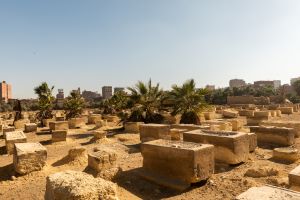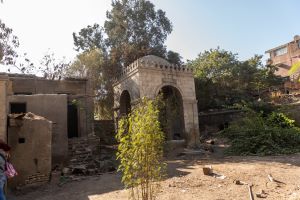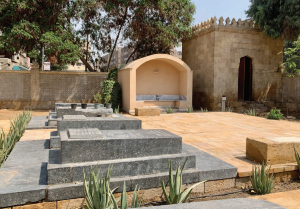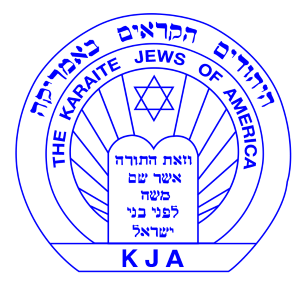Click HERE to see the full cover story on Basatin from our Fall 2021 Issue of Scribe Magazine.
The Jewish cemetery in Basatin is the third oldest operational Jewish cemetery in the world, having been officially established by decree of the Mamluk Sultan al-Ashraf Qaitbay in 1482. At the time, the land designated for the cemetery consisted of 147 acres and was located beyond the boundaries of the Tulunid capital of Egypt, with separate grounds for Rabbanite and Karaite Jews. Over the centuries, the cemetery became fragmented into disconnected plots of land now amounting to about 27 acres. These plots consist of the common burial grounds, known colloquially as the Basatin cemetery, the Mosseri family cemetery, the Ades family cemetery, the Ventura family cemetery, the Rav Haim Capusi cemetery, the Moise Cattaui Pasha family cemetery, and two surviving Karaite family cemeteries of Menasha and Lichaa families. With the exception of the Mosseri cemetery, which is under the supervision and protection of the Egypt Ministry of Tourism and Antiquities, the other cemeteries remain under the care of the Egyptian Jewish community in Cairo, represented by the Drop of Milk Association.
Preliminary Conservation Work
Thanks to a generous grant from the U.S. Ambassadors Fund for Cultural Preservation (AFCP), ARCE, in partnership with the Drop of Milk Association and the US Embassy in Cairo, was able to undertake preliminary conservation work and produce a management plan to guide any future interventions at the site.
Before
In the initial project phase, the team performed a condition analysis, topographic survey of the remaining graveyards, an engineering study of remaining structures, a geophysical soil analysis, and material testing. Architectural drawings were also completed to reflect both the original state and condition after receiving conservation. All cemeteries underwent extensive solid waste removal in order to proceed with conservation.
During
Following this preliminary work, the Karaite cemetery was then selected for more focused efforts. Extensive work to repair the breaches in the perimeter walls of the cemetery were a priority. Conservation activities included the cleaning of the original marble plaques in the graveyards and burial covers, as well as refitting those which were displaced from their original positions. As the gathering
After
rooms’ roofs were at risk of collapse, several interventions were needed, namely ceiling refurbishment and support, roof installation, and isolation in order to prevent further damage. All woodwork required replacement or refurbishment, and the renovated windows and doors were treated to safeguard future sustainability. The dome of the Menasha family tomb received extensive conservation work, consisting of ceiling consolidation, restoration and installation of columns to the two gravestone bases, and refurbishment of the mosaic flooring in the interior.
The Garden of Remembrance
In September 2020, David Ovadia, President of the Karaite Jews of America (KJA), and his wife Maryellen Himell-Ovadia attended an ARCE webinar on the preliminary work in Basatin. Following the lecture, it became clear to the Ovadia’s that a partnership between the KJA, Drop of Milk, and ARCE would serve as an incredible opportunity to infuse ARCE’s project with a living memorial to the Karaite community’s lost heritage in Egypt. “Our community came out of Egypt, and we still have very strong traditions and memories from Egypt,” said Ovadia. After several meetings with ARCE to develop schematics and plans for the proposed Garden of Remembrance, the Ovadia’s began to connect with Karaite Jews all over the United States to share the vision for the Garden, raise funds, and collect stories and oral histories of those whose families are laid to rest at Basatin.
Thanks to a generous donation from the Karaite Jews of America (KJA), ARCE worked in partnership with KJA and Drop of Milk to install the Garden of Remembrance honoring The Karaite Jewish Community of Egypt. The space is now complete with walking paths, outdoor benches, date palm trees, lush landscaping, and enhanced signage. Additional touches include the installation of bilingual visitor information panels in the family room in the Menasha plot. These offer information on the Egyptian Karaite Jewish community and its thousand-year history in Egypt.
Giving Life to the Stones: A Philanthropic and Cultural Partnership
It is the strength, resilience, and living culture of the Karaite community that Ovadia hopes to spotlight in the present day and to carry on into the future. Both Ovadia’s saw the creation of the Garden of Remembrance as a catalyst to further knit the Karaite community together, to tell its own story to the wider community, and to celebrate the connections of the living Karaite Jewish culture to the larger Jewish world. “If the living Karaite community does not recognize its roots, its rich history, and its ancestors, we fear that no one will in a way that does justice to the personal narrative of so many fascinating individuals who represented the mosaic of the Karaite Jewish community of Egypt over the centuries,” Ovadia explained.
“While there is no longer a living Karaite Jewish community in Egypt, our thousands of members dispersed throughout the world take tremendous pride in our community’s millennium-plus heritage. Many of us understand there is a real need to keep our rich history alive for the next generations.”
“It has been interesting to see how ARCE’s project to protect the cemetery – a city of the dead – has evolved into a celebration of a living culture,” Himell-Ovadia added. While some of their outreach was initially met with skepticism from those who had mixed emotions about the past or had personally seen Basatin in disrepair, the Ovadia’s were able to excite many of their community members about the project and ultimately raise the funds needed to create the Garden of Remembrance. David Ovadia noted, “To me, this project means identity. It means pride. It means that we have reestablished a palpable connection to our past. As a people, and for the benefit of future generations, we are so much stronger when we know where we came from, as well as where we are going. Supporters in the community are now telling me ‘You are doing a big Mitzvah, David,’ and ‘Thank you for your efforts in this historic project as it means a lot to my wife and I.’”



